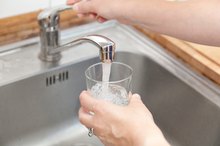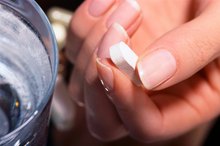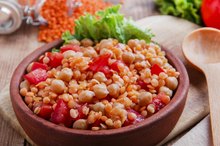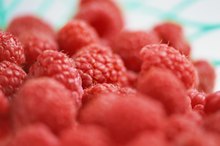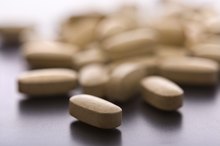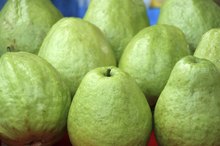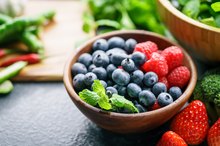What Can You Eat During a Liver Cleanse?
The liver is the primary site in the body for detoxification, and to help ensure that the liver is able to function as this cleansing organ, it's vital to support it through diet 1. The body continually cleanses itself through a two-stage process, with each stage requiring different nutrients. For a liver cleanse to be effective, it's important to eat a variety of nutrient-dense foods.
If you are experiencing serious medical symptoms, seek emergency treatment immediately.
The Process of a Liver Cleanse
A cleanse, or detoxification plan, refers to removing the buildup of toxic substances from the body. Many toxins are fat soluble, and they must be attached to a water-soluble molecule to be excreted in urine. The two stages of detoxification in the liver are known as phase I and phase II. Phase I makes changes to the toxin so that it can accept a water-soluble molecule in phase II and be excreted. Often, the by-products from phase I are more toxic than the initial toxins, and the completion of phase I results in the generation of many free radicals that can damage cells in the body. Therefore, it's essential that phase II is able to perform its function. The liver requires nutrient-rich foods to support both detoxification phases 1.
- A cleanse, or detoxification plan, refers to removing the buildup of toxic substances from the body.
- Often, the by-products from phase I are more toxic than the initial toxins, and the completion of phase I results in the generation of many free radicals that can damage cells in the body.
Macronutrients: Protein, Carbohydrates and Fat
What Are the Benefits of Water on Liver Detoxification?
Learn More
Good-quality protein is necessary for both phases of liver cleansing. Such foods would include:
- fish
- meat
- poultry
- dairy products
- eggs
- beans
Carbohydrate consumption should be regulated, because too-high consumption prevents the amino acids in protein from activating an important enzyme involved in phase I. Complex carbohydrates, which include
- whole grains such as brown rice
- whole wheat products
- barley
- quinoa
- are recommended
- because simple carbohydrates
- such as sugar
- inhibit phase I
Dietary sources of fat provide important energy required for a liver cleanse. The best source of fat would be from medium chain triglycerides, such as coconut oil 4.
- Good-quality protein is necessary for both phases of liver cleansing.
Foods Rich in Antioxidants
During a liver cleanse, a high number of free radicals will be produced. Foods rich in the antioxidant nutrients -- vitamins C and E, and also selenium -- help prevent these free radicals from causing damage to cells in the body. Choose citrus fruits, guavas, papayas, broccoli and peppers for vitamin C, whole-grain products and almonds for vitamin E and leafy green vegetables, such as:
- turnip greens
- spinach,which are rich in both vitamins
Fish, eggs, seafood and Brazil nuts are good sources of selenium. Flavonoids, a component of many berries, such as
- blueberries
- raspberries
- blackberries
- are also good antioxidants
Green tea has an abundance of catechins, powerful antioxidants that could provide support to the liver during a cleanse.
- During a liver cleanse, a high number of free radicals will be produced.
- Flavonoids, a component of many berries, such as * blueberries
* raspberries
* blackberries
* are also good antioxidants Green tea has an abundance of catechins, powerful antioxidants that could provide support to the liver during a cleanse.
Other Dietary Considerations
Does Cranberry Juice Help to Detox the Liver?
Learn More
Cruciferous vegetables are ideal to support the liver, because they contain B vitamins to assist with phase I, sulfur to support phase II and vitamin C to function as an antioxidant. Examples of such foods include broccoli, Brussels sprouts, watercress and spinach. Throughout a liver cleanse, it's vital to ensure sufficient consumption of pure water. The liver will be converting toxins to water-soluble compounds to enable their removal from the body, so adequate water intake is essential to ensure excretion of these toxins from the body in the urine, which is the fundamental purpose of a liver cleanse.
- Cruciferous vegetables are ideal to support the liver, because they contain B vitamins to assist with phase I, sulfur to support phase II and vitamin C to function as an antioxidant.
Related Articles
References
- Applied Nutritional Science Reports: The Role of Detoxification in the Prevention of Chronic Degenerative Disease: DeAnn J. Liska
- Harvard School of Public Health: Protein: Moving Closer to Center Stage
- NYU Langone Medical Center: Medium-Chain Triglycerides
- Dietetics of Canada: Food Sources of Vitamin C
- National Institutes of Health, Office of Dietary Supplements: Selenium
- USDA: Sources of Flavonoids in the U.S. Diet Using USDA’s Updated Database on the Flavonoid Content of Selected Foods.
- Life Extension Foundation for Longer Life: Metabolic Detoxification Additional Aspects of the Detoxification Process
- American Institute for Cancer Research: AICR’s Food That Fight Cancer
Writer Bio
Rebecca Fairchild has always had a passion for food and health, and began training as a nutritional therapist in her early twenties with Premier Training International. Since qualifying in 2010, Fairchild has been a keen nutrition writer, actively using her work to educate others on ways in which they can optimize their health through their diet and lifestyle choices. Fairchild has been published in Healthy Juicing Magazine.
